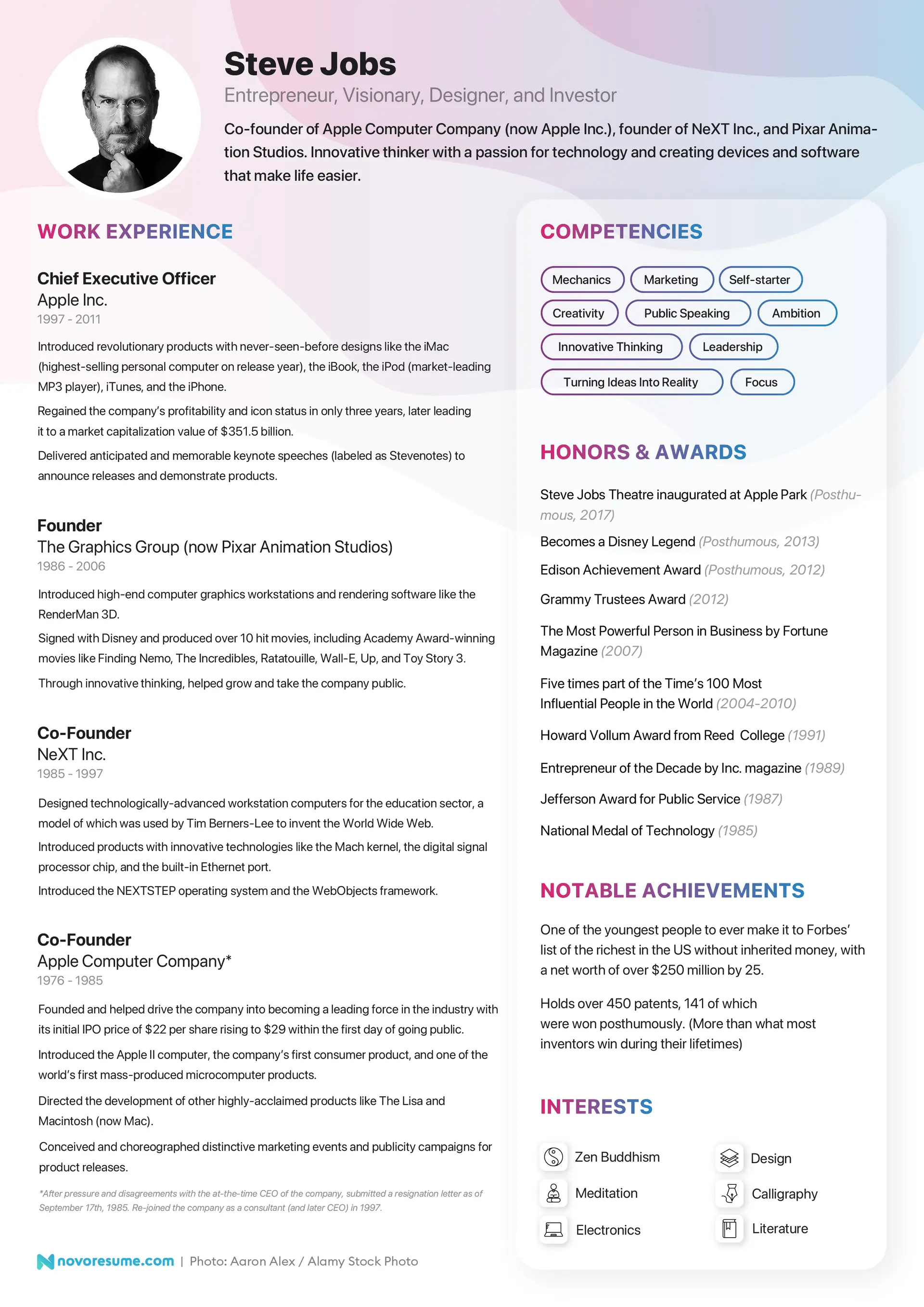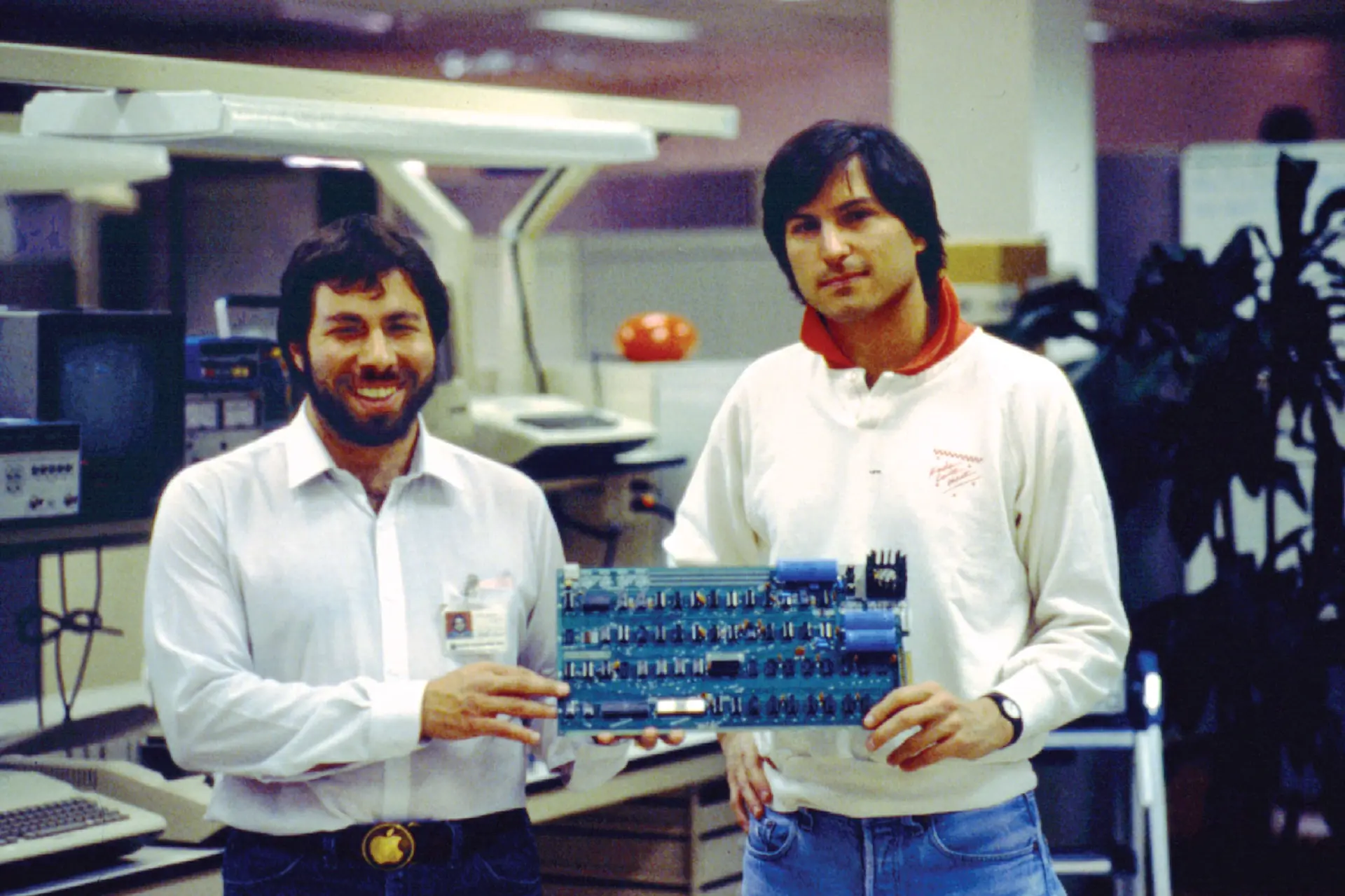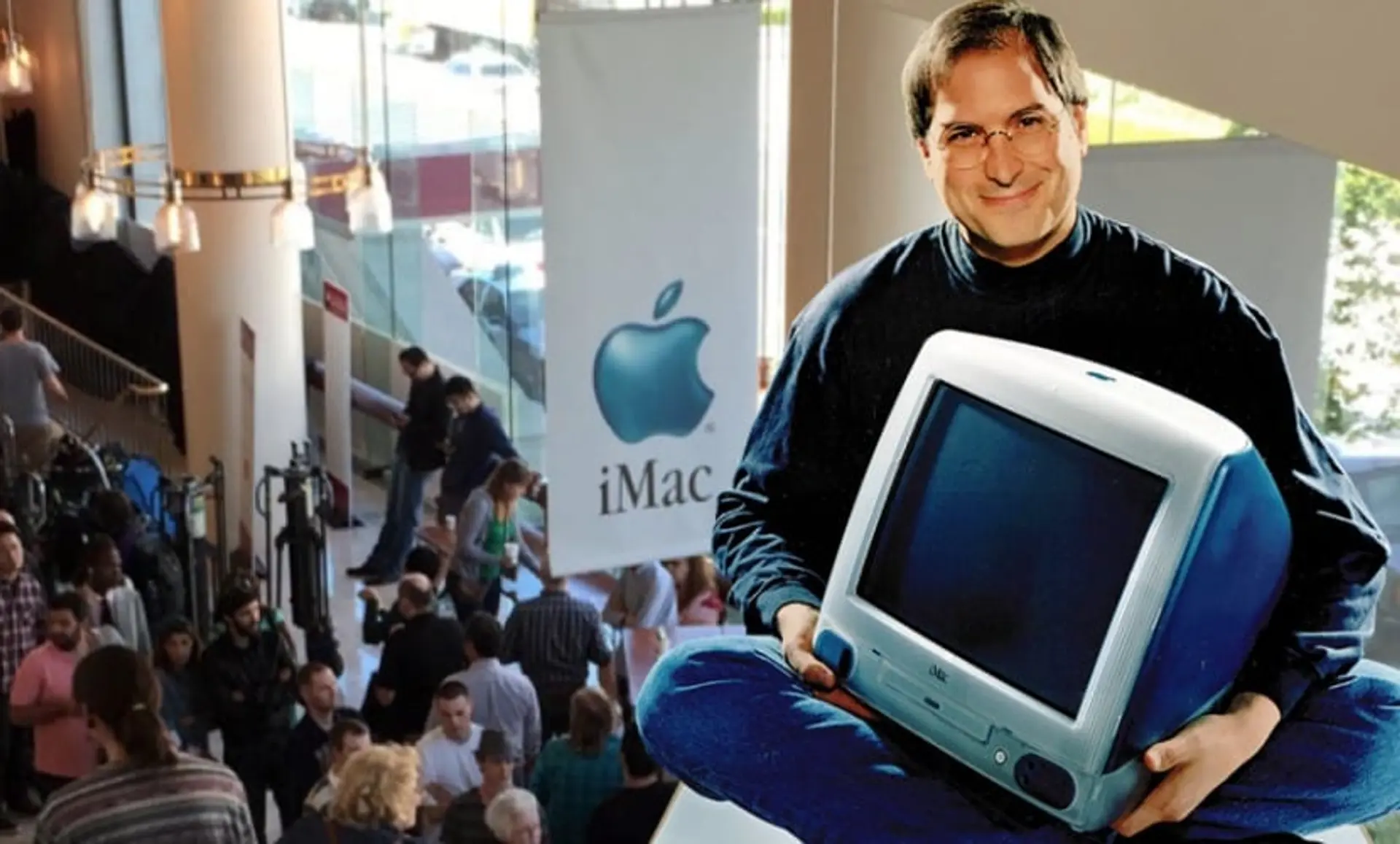
Whether it was through your old MP3 player, your very first personal computer, or your favorite animation movie as a kid, Steve Jobs has surely impacted and forever changed your life and lifestyle.
Co-Founder of Apple and Pixar, the late Steve Jobs is known and remembered in every corner of the world.
As one of the most visionary entrepreneurs of all time, he became one of the youngest people to enter the Forbes list of the richest of the US.
He co-founded and launched three major companies, with Apple becoming the first publicly-traded company to reach a market capitalization of one trillion USD in 2018.
Listing all his achievements and contributions to the technological world in a paragraph is near impossible, so you’re probably thinking there’s no way for Jobs’ resume to be one page only, right?
Well…to your (and most people’s) surprise, that’s very much possible!
To commemorate Steve Jobs’ birthday on the 24th of February, we at Novorésumé decided to prepare a little something.
Read on for the story of the charismatic and stubborn man that revolutionized technology, told through his one-page resume! (It is somewhat unfair to fit his whole life in one page, as he represented so much more.)

The Story of a Visionary
If you found Jobs’ resume impressive and want to know more, you can find a more detailed story of his life and career below!
Pre-Apple Times
Ever since he was a child, Jobs didn’t have a smooth relationship with the school or with his peers. He found the subjects boring, resisted authority figures, and was suspended quite often due to his misbehavior.
His adoptive father never blamed him for this, though.
Instead of trying to get Jobs to “fit in,” he decided to turn their garage into a workshop and introduce Jobs to the world of mechanics.
Influenced by his father, 10-year-old Jobs found himself very interested in electronics and made friends with the engineers living in his neighborhood.
A few years later, in high school, Jobs took his first and only electronics class, Electronics 1, which he soon lost interest in. It’s around this time that he was introduced to who would later become Apple’s co-founder, Steve Wozniak.
In 1971 the two had their first business endeavor and started selling a low-cost digital “blue box” that they both built according to Wozniak’s design. The successful sales got Jobs thinking about how electronics could be both fun and profitable.
Surprisingly enough, however, he didn’t end up studying anything related to the field. He enrolled in the English course at the expensive Reed University and studied Shakespeare, calligraphy, and dance.
After just one semester, Jobs dropped out, started working as a technician at Atari Inc., and used the money he made to go on a 7-month trip to India in search of spiritual enlightenment.
When he came back, Steve Wozniak, his childhood friend, was already working on his Apple I computer, which he completed in 1976. After H&P rejected the model, it was Jobs’ idea that he and Wozniak get into business together and sell the computer themselves. Thus began the Apple Computer Company, operating from Jobs’ bedroom and garage.

The Beginnings of Apple
The initial funding for the company was provided by selling Jobs’ Volkswagen van and Wozniak’s programmable calculator. That was enough for them to build their first batch of circuit boards and put it out there.
Soon after, they received an order for 50 fully assembled units of the Apple I. Fundings and investments started to come in and the company was on the rise.
After the Apple I, Jobs encouraged Wozniak to design an improved model of the Apple I (called the Apple II) and managed to secure the funding for it.
The model was an immediate success and initiated the boom in personal computers.
This particular moment and success highlighted Jobs’ visionary thinking and marketing skills.
A few days after the release of the model, Apple went public and entered the Fortune 500 list of America’s top companies in record time.
In 1983, Jobs convinced PepsiCo Inc.’s president, John Sculley, to become Apple’s CEO. “Do you want to spend the rest of your life selling sugared water, or do you want a chance to change the world?”, he’d asked Sculley.
During this period, Jobs went on a tour of the Xerox PARC computer research lab and was introduced to breakthrough technologies like the graphical user interface (GUI) and the mouse. He insisted that both of them be used on the products they were developing at the time: the Lisa and the Macintosh.
Unfortunately, the Macintosh didn’t have the expected success. It was expensive and underpowered and sales were disappointing. This “failure” created tension between Jobs and the CEO, John Sculley, and eventually led to Jobs resigning from the company.
Jobs sold all his shares apart from one, which he claimed he only kept so he could receive the company’s report in the mail.
NeXT & Pixar Phase
Immediately after leaving Apple in 1985, Jobs started NeXT Inc. with the purpose of designing computers with the highest standards to be used in the education sector.
The first release, the NeXT Cube, was indeed great, but at a price tag of $9,999, it was way too overpriced for universities. The release after that, the NeXT Station was followed by the same fate and had very slow sales.
This led the company to give up on hardware and focus on its innovative software system, the NEXTSTEP.
At the same time as Jobs was working on NeXT, he became interested in Pixar, a computer graphics firm that was a subdivision of Lucasfilm Ltd. As soon as Pixar became independent in 1986, Jobs paid $5 million for technology rights and invested another $5 million in the firm as capital, becoming chairman of the company.
After some experimenting with hardware products, Jobs realized that the animation business was what was keeping Pixar alive and in 1991 signed a deal with Disney to make a full-feature computer-animated movie: the Toy Story.
The animation was, of course, an immediate success. Jobs took Pixar public the week following the release of the movie and, owning over 80% of the shares, came to have a net worth of over $1.5 billion. This was five times more money than he had made at Apple.
The Return & Reinvention of Apple
While Pixar was thriving, Apple was going through some hard times.
A new CEO, Gil Amelio, took charge in 1996 and made efforts to turn the company around. He decided that Apple should acquire a new operating system to compete with Microsoft: the NEXTSTEP.
Steve Jobs, however, convinced Amelio to purchase NeXT Inc. entirely, becoming part of Apple once again as a consultant. This position didn’t last long as Jobs quickly became the interim CEO (and later CEO) once more when Amelio was discharged in 1997.
In the crucial years to come, Steve Jobs’ smart decisions returned Apple’s status in the industry. He rethought the company’s product line, engineered an award-winning Macintosh campaign, and most importantly, refused to make Apple’s products run on Microsoft’s Windows OS.
In May 1998, the iMac was introduced. A true innovation with its fashionable translucent design and high-speed processing, the iMac became the highest-selling personal computer in the US by the end of the year.

The iMac was only the beginning of a series of innovative products that would soon take over the market.
The iBook was the first one - a stylish laptop computer designed for students. Next came the iTunes and iPod and in 2003, Apple started selling downloadable copies of songs in MP3 format through its online iTunes Store.
In 2007 the company, which up until then was called the Apple Company, was renamed Apple Inc. That same year the iPhone and iPod were introduced. The keynote speech for the introduction of the iPhone is to this day one of the most memorable of Jobs’ career.

The iPod Touch came soon after with built-in Wi-Fi and a touch screen. These releases opened the door to the gaming world and Apple products became the biggest portable game carriers.
During all this time, Jobs also remained CEO at Pixar. The company’s relationship with Disney was not that smooth and after the releases of several hit movies like A Bug’s Live, Toy Story 2, Monsters Inc., and Finding Nemo, their deal on collaborating for computer-animated feature films was broken off.
A few years later, Bob Iger was nominated as the new CEO of Disney and a new page was turned for the company. The relationship with Pixar was fixed, leading to Disney purchasing the company entirely in 2006. Jobs became Disney’s largest shareholder (owning 7%) and board member.
In the remaining years at Apple, Jobs decided to re-discuss the idea of a tablet, which had been previously discarded. The tablet, called iPad, would run on the same operating system as the iPhone, the iOS. Despite the misleading initial skepticism, 450,000 iPads were sold in the first week after the release in April 2010.
In 2011, iCloud was introduced, which helped drive the sales of iPads (and other devices) even more. Being able to sync data between all devices was a very helpful tool for the users, and it helped encourage them to enter the Apple ecosystem entirely.
The iCloud revelation was Jobs’ last Stevenote. With his health deteriorating, he decided to make a few crucial decisions that would prepare the company to operate without him.
He created “Apple University”, an internal training program for future Apple executives, and he appointed Yale School of Management’s dean to lead it. He appointed COO Tim Cook as his successor and resigned as CEO in August 2011.
On October 5th, 2011, one day after the introduction of the iPhone 4S, Steve Jobs passed away at his home, surrounded by his family.
He left behind a legacy of innovation, becoming an iconic entrepreneurial figure cuntless people look up to.
